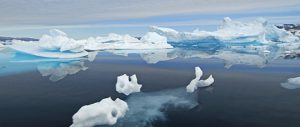Disko Bay lay glinting with ice on the bright afternoon we sailed in. Icebergs as big as buses floated among others the size of houses. But houses from another world – these were castles and fairy grottoes, crazy monumental statues sculpted into fantastical shapes by the sea, the wind and the pressure of centuries of falling snow. Pools of unearthly blue water shimmered on their surfaces. One iceberg with five straight sides – on the surface, an exact cube – drifted slowly, slowly by, its geometry bewitching.
These were just the beginning. Further on were floating mountains, ice cliffs hundreds of metres tall, marching forth from the mouth of the glacier that reaches the sea at Disko Bay. Most of these break up or are worn down before they get here, but some last for years, as huge and menacing as when they were calved from the Jakobshavn Isbrae, the most productive glacier in the northern hemisphere. Every year, 35 billion tonnes of ice break free of the Greenland ice sheet here. Only the mammoth glaciers of Antarctica can compare. The Isbrae – also known as Sermeq Kujalleq – moves at 40 meters a day. For glaciers, this is pretty quick.
Glaciers have always made their way to the sea. Snow falls on the vast Greenland ice sheet – this is by far the world’s biggest island – and the weight pushes out the ice at the edges. But the remarkable thing about the Jakobshavn Isbrae – and nearly all of Greenland’s glaciers, and most of the glaciers in the world – is how fast those outward waves are flowing now.
In 2002, when researchers measured the Jakobshavn Isbrae, which drains 6.5% of the Greenland ice sheet, it was moving only half as quickly as it is today, and pouring only half the present volume of ice into the fjord. The earliest known maps of this glacier date from the 1850s, but observations of it have intensified since the 1950s. They track the marked acceleration of the ice over recent decades, and show its speed increasing dramatically in the past few years. The Helheim glacier, draining 4% of the Greenland ice sheet, tells a similar story. Its speed increased from eight kilometres a year in 2000 to 11 kilometres a year in 2005, and has since accelerated.
The reason the glaciers are speeding up is simple: Greenland is getting warmer. Jacqueline McGlade, director of the European Environment Agency (EEA), says: “The amount of ice that is being lost is far more than we thought. Greenland is warming faster than the computer models predicted, and that is a worry.” The Arctic has warmed at three times the rate of the rest of the world in the past 100 years, and temperatures continue to rise. Ola Johannessen, chief of Norway’s Nansen Environmental and Remote Sensing Center (NERSC), has worked on ice for more than 30 years. He has never seen anything like the current situation. “There is no doubt that what we are seeing is the result of global warming,” he says. “The glaciers are moving faster. Ice is being lost from the Greenland ice sheet, and that will raise sea levels.”
In the past two decades, the evidence for global warming has piled so high it is no longer disputed by mainstream scientists. Much of this evidence has come from Greenland, as have the long climate records that have allowed scientists to predict the future progress of global warming. Now, on the eve of the most important meeting on climate change ever held – the United Nations conference in Copenhagen this December – politicians are looking closely at Greenland – both as time capsule and as crystal ball – and are attempting to face up to the dangers the ice foretells.
On top of the Jakobshavn glacier, where we landed in a helicopter, Danish government official Frederik Schmidt poured glasses of whisky and filled them with chunks of ice he had chipped from the edge of the glacier. They fizzed when they hit the liquor. “Thousand-year-old air!” he grinned. Greenland holds within its ice the history of past climate changes. Each year, a new layer of snow settles and that snow bears in tiny bubbles the traces of the atmosphere at the time it fell. Over the centuries, the snow is compacted but the layers remain. Scientists have learnt to drill kilometres deep and bring up cylinders of ice, cores that can be carefully sliced and analysed. The bubbles within them reveal characteristics such as the level of carbon dioxide in the atmosphere when they were laid down. In this way, researchers have painstakingly amassed a history of the earth’s climate over the past 100,000 years.
The tale the ice cores tell is full of foreboding. Climate changes of the past have not been slow, gradual increases in temperature. Rather, they have been abrupt – sudden and steep warmings and coolings, sometimes over a matter of decades. This has led researchers to suggest that certain feedback loops, or tipping points, exist in the earth’s climate system – points at which the warming or cooling becomes self-reinforcing and much more rapid. Some feedback effects are already at work in Greenland.
Stand on top of a glacier, far from where the bergs calve with loud cracks, and you hear a strange background murmur, a ceaseless whispering that appears to have no source. This is the sound of meltwater rushing down through fissures in the ice. When it reaches the bottom, the water lubricates the flow of the ice over the rocks beneath, speeding the glaciers on their way. The more meltwater, the more lubrication and the faster the ice moves.
Other tipping points might include the rapid disappearance of the Amazon rainforest, which could be caused by drought. If that happened, all the carbon the forests absorb would be released, and global warming would accelerate. If temperatures rose more than 4° Celsius above pre-industrial levels, catastrophe would ensue, according to the Intergovernmental Panel on Climate Change (IPCC). More than one-third of the world’s species would disappear; hundreds of millions of people would face famine; floods and storms would whip rich and poor countries alike.
Looking out over Disko Bay and the Ilulissat ice fjord from the balcony of the world’s northernmost four-star hotel this July stood a group of politicians and officials from 29 countries. They were called here by Connie Hedegaard, the forthright Danish environment minister and former TV journalist charged with leading the Copenhagen meeting in December, where the world will attempt to agree a new international treaty that will bind countries to cut their greenhouse-gas emissions and tackle the effects of climate change before it is too late.
“Every year we delay, the greater the damage of climate change and the more expensive it will be to tackle it,” Nicholas Stern, author of the landmark 2006 review of the economics of climate change, told me. “It is very important that we get a deal at Copenhagen.” The world’s previous attempt to draw up a framework that would commit countries to lowering their emissions ended in failure after more than a decade of wrangling. The Kyoto protocol required developed countries to cut their emissions by an average of 5% by 2012. Poor countries had no emissions-reduction targets, but would benefit from green investments made by the richer nations on the understanding that this would help them move from high-carbon to low-carbon economic growth.
Kyoto was greeted as a triumph in 1997 when it was signed, but scarcely was the ink dry than the whole project collapsed. It became clear the United States Congress would never ratify it. Other countries, such as Russia and Australia, also refused to do so for many years, and some – notably the Japanese and Canadians – tried to wriggle out of aspects of their commitments. When George W Bush took office as US president, Kyoto looked to be on the scrapheap of history.
In one of the tortuous turns that climate negotiations so often take, the protocol eventually came into effect, eight years late, in 2005. But by then it was clear that few countries would meet the obligations they had agreed. Global emissions rose at ever faster rates. The resurrected protocol stated that the period from 1997 to 2012 would be the first of many “commitment periods” in which governments would agree ever stiffer targets to reduce greenhouse gases. With the first deadline in 2012 looming, a worldwide effort has begun to forge a new framework – even if the first commitment period has largely been ignored.
Things have changed since Bush left office. Now no country wishes to be left out and all profess eagerness for a deal. But divisions remain, as deep as the cracks in Greenland’s ice. According to poor countries, the emissions cuts that rich countries have offered are inadequate, as are the sums they are willing to commit to help to build clean energy sources in the developing world. Meanwhile, the developed world complains that emerging economies – which will soon be responsible for, by far, the biggest slice of global emissions – will not adopt the targets demanded.
There have been dozens of formal and informal political get-togethers – like July’s Ilulissat meeting – aimed at breaking the deadlock. But agreement on the big issues seems as distant as ever. Some observers believe there is little hope of writing a strong treaty at the Copenhagen conference, so it would be better to carry on negotiations for another year.
“If it looks like we would be left with a bad deal, it would be better to have a moratorium on the talks and wait a year,” said David King, former chief scientific advisor to the British government and the man who made Tony Blair take climate change seriously. This argument cuts no ice with the Danes running the conference. “There is no plan B,” Hedegaard said firmly, fixing me with a frown. “We need to have a deal at Copenhagen. That is the deadline, and it will be hard work, but we can make it.”
NEXT: Life among the Greenlanders
Fiona Harvey is the Financial Times environment correspondent
Copyright The Financial Times Limited 2009.
Homepage image by arjanveen



